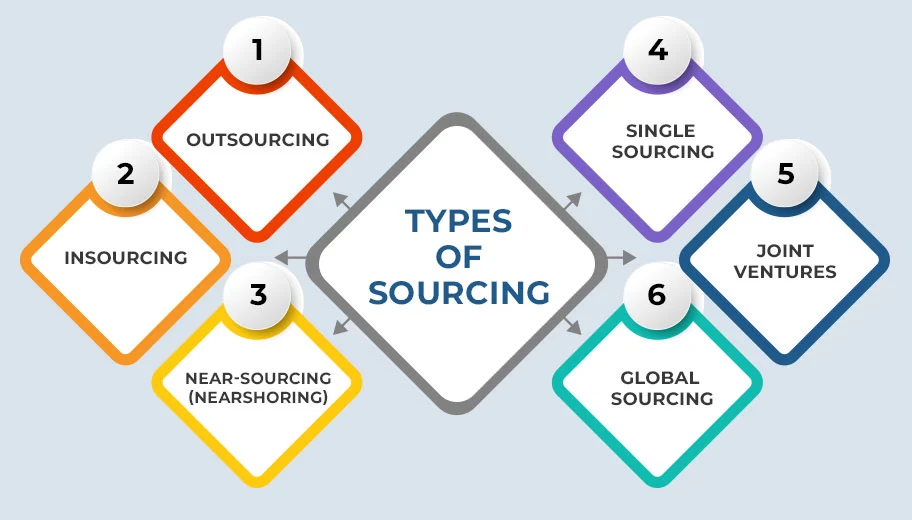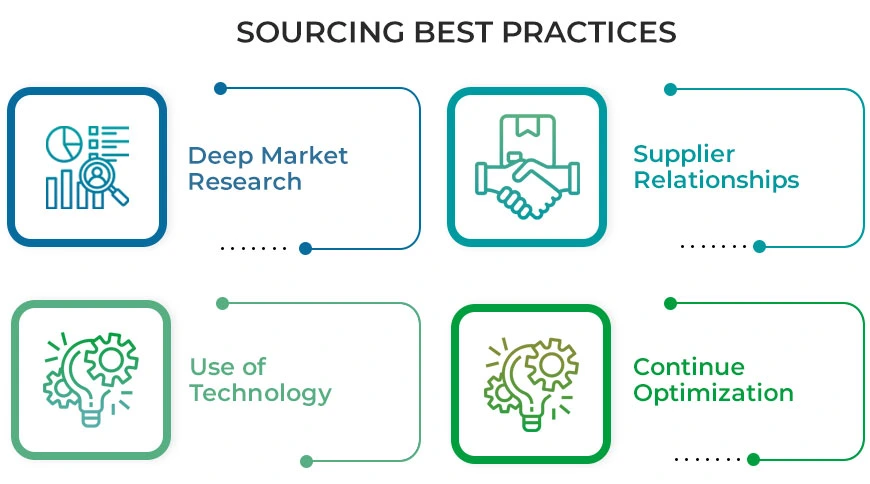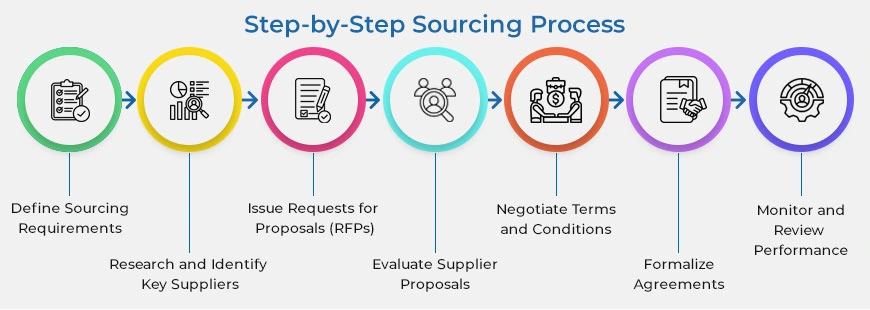What is Sourcing? Everything You Should Know
Everyone knows about Apple, when you think about it, you see great design and advanced technology. But what many don’t see is their sourcing process. Instead of making all the products themselves, Apple works with trusted companies across the world to get components like chips, screens and batteries.
This helps them with costs, saves time and focuses on creating better products. So, in this blog, we will know what sourcing is and how it can help in any business to grow.
What is Sourcing?
The process of finding and choosing suppliers who can supply goods or services to fulfil the business goals is called sourcing.
Definition and Meaning of Sourcing
We can define sourcing as the method of identifying, analyzing and selecting potential suppliers that offer the best value. It involves planning, finding reliable supplier relationship management, studying the market, and contract management and making sure everything follows the rules before making a deal.
Sourcing means it helps companies build a strong supply chain by choosing the right partners, negotiating terms, and creating contracts to meet their operational needs.
What is Strategic Sourcing
Sourcing is the process of finding suppliers that offer the best value for any goods or services. It’s about getting the things on lowest price. But in strategic sourcing, it focuses on long-term value, reliability, service, quality and compatibility with business objectives.
Tactical sourcing is about the short-term actions you take to support that strategy. It focuses on how to get things done step by step.
Sourcing vs. Procurement: Key differences
Sourcing and procurement are related but different. Sourcing is finding and opting suppliers, while procurement teams cover the complete process of acquiring goods and services, from identifying needs to placing orders, receiving goods, and processing payments.
Key Features of Sourcing
Here are some key features of Sourcing, let’s jump into it:
- You can identify and evaluate the best suppliers based on performance, reliability, and pricing.
- You can use insights and data to learn about market trends, price standards, and what suppliers can offer.
- Track expenses, analyze spending patterns, and negotiate better deals to reduce procurement costs.
- You can proactively detect and manage supplier risks, delivery delays, and compliance issues.
- Simplify contract creation, approvals, and renewals, while ensuring compliance and visibility.
- You can simplify the tasks like RFQs, approvals, invoicing for faster, and error-free procurement.
Types of Sourcing

There are many examples of Sourcing, which we are understanding here:
Let us know
Outsourcing
Outsourcing means hiring another company, either nearby or abroad, to do work or make products that your own team would normally handle. It helps reduce costs, get expert skills, and save time for other important tasks.
Insourcing
Insourcing means doing the work in-house using your own team and resources instead of hiring a third party. Businesses often choose this route to save money, maintain better control, or ensure higher quality in certain operations.
Near-Sourcing (Nearshoring)
Near-sourcing is about shifting production or supply activities closer to where your products are sold. This helps reduce shipping time, lower transportation costs, and make the supply chain more responsive to customer needs.
Single Sourcing
Single sourcing is another type of sourcing that includes partnering with just one supplier for a specific product or service. While it can simplify processes and build a strong supplier relationship, it also means your business relies heavily on that one source.
Global Sourcing
Global sourcing is when a company buys materials, products, or services from international suppliers. It gives access to cost-effective options and unique expertise, but managing time zones, shipping, and regulations can be more complex.
Joint Ventures
A joint venture is when two or more companies’ team up to share their resources, knowledge, and risks. In sourcing, it helps businesses strengthen their position, share investments, and reduce exposure to market uncertainties.
Key Benefits of Sourcing
Here are several benefits of sourcing:
Cutting Costs: Companies that follow strategic sourcing practices often save more than 8% each year by using data to make better decisions and reviewing sourcing with a big-picture approach.
Better Quality: With competition, sourcing quality suppliers is key. Good sourcing ensures you deliver reliable products and helps track supplier performance based on real customer feedback.
Supply Chain Stability: The pandemic highlighted how fragile supply chains can be. Building strong and dependable relationships with suppliers makes your business more prepared and flexible.
Lowering Risks: From political shifts to natural disasters, many things can disrupt supply. Sourcing Strategies help you stay ahead by planning for such potential risks. In fact, companies using contract-based sourcing see much better compliance rates.
Brand Reputation: Today, your brand’s image matters as much as your product. Clear sourcing practices and ethical supplier choices help build trust and loyalty among customers.
Sourcing Best Practices

- Deep Market Research
Gaining a clear view of the supplier selection ecosystem and current market trends empowers smarter, more strategic sourcing decisions. - Supplier Relationships
Cultivating trusted partnerships with suppliers encourages collaboration, reliability, and long-term partnership creation. - Use of Technology
Implementing e-sourcing tools and leveraging data analytics boosts transparency, speeds up processes, and supports better decision-making. - Continue Optimization
Consistently evaluating and updating sourcing strategies ensures they remain aligned with business processes and shifting market conditions.
Sourcing Strategies Need to Focus On
Creating a solid sourcing strategy is key to improving your procurement process and setting your business up for long-term goals. Here’s a simple, step-by-step guide to help you develop a strategy that drives efficiency and supports sustainable growth:
- Set Clear Goals
Start by defining what you want to achieve with your sourcing strategy. Of course, cost reduction and supplier performance are important, but don’t forget about other areas like nurturing innovation, encouraging teamwork, and bringing continuous improvement. Set measurable targets and KPIs that keep everyone focused on what matters.
- Past and Current Performance
Take a deep dive into both your historical data and current performance. With modern analytics tools, you can easily combine past data with real-time insights. And don’t dominate the wisdom of your team on the field, they often have the most valuable feedback about how things really work.
- Dig Into Competitor Insights
Market research and competitor analysis are important. Stay on top of what’s happening in your industry and with your competitors. Keep an eye on news, trends, and customer feedback. You can even use the same analytics tools you use internally to get a clearer picture of what’s going on outside your business function. The more informed you are, the better your sourcing decisions will be.
- Regular Audits and Supplier Check-Ins
Ongoing audits and performance reviews are vital for maintaining strong supplier relationships. If you haven’t been doing this regularly, it might feel awkward at first, but it’s crucial for staying on top of things. By having a clear strategy for managing relationships with suppliers from the beginning, you can ensure that everyone stays aligned and accountable.
Step-by-Step Sourcing Process

You are just few steps away from setting up a sourcing process:
- Define Sourcing Requirements
Start by analyzing your company’s precise needs, what products or services are required, in what quantities, and within what time frame. Utilize both past data and insights to outline clear objectives and the scope of your sourcing strategy. - Research and Identify Key Suppliers
Conduct in-depth market research to identify suppliers who can meet your needs. Consider factors like suppliers’ reputation, financial stability, and delivery capabilities. Establish clear criteria to make the selection process more efficient. - Issue Requests for Proposals (RFPs)
Distribute well-defined RFPs to your shortlisted suppliers, detailing your needs, deadlines, and evaluation criteria. This helps suppliers submit proposals that are better aligned with your requirements. - Evaluate Supplier Proposals
Assess received proposals against your selection criteria. Using e-procurement platforms can streamline this process, enabling faster communication, automated analysis, and more informed decision-making. - Negotiate Terms and Conditions
Engage in detailed negotiations to agree on essential terms such as pricing, delivery timelines, and payment conditions. Ensure transparency and document every aspect of the agreement to set clear expectations. - Formalize Agreements
Finalize the contract with the chosen supplier through a legally binding agreement. Ensure all terms are well-documented and consult legal experts to ensure all legal aspects are covered. - Monitor and Review Performance
Regularly evaluate supplier performance through audits and feedback sessions. Address any issues swiftly to maintain product quality and nurture long-term processes, contracts, mutually beneficial partnership.
How to Choose the Right Sourcing Software
Before taking a decision to pick sourcing software in your organization, you need to check a few criteria that will help you to benefit your organization in the long run. Wrong software can also impact adversely your business operations. So, we mention a few factors before choosing the right software:
Identify needs: Start by identifying your biggest pain points. Involve your team, list what matters most, and choose a solution that truly simplifies your workflow.
Check the compatibility: Figure out if cloud or on-premise software suits your team best. Then, mark your goals like better expense control or smoother approvals to find a solution that truly fits.
Review and ratings: Before picking software, check real user reviews on Capterra or G2 for honest insights on usability, support, and value.
Business case: After shortlisting tools, build a simple business case. Show how the software saves time, cuts costs, and grows with your needs. Focus on real benefits for each team to get everyone on board.
Check capabilities: In software demos, focus on your company’s needs, test key features, and compare options. Be cautious of overhyped claims and ensure the solution fits your requirements before deciding.
Challenges of Sourcing

If you are new to that field, you may face some challenges like:
- Lengthy Supplier Onboarding
Traditional onboarding often involves complex paperwork, multiple approvals, and slow evaluations. To streamline the process, implement standardized workflows and leverage modern cloud-based platforms to accelerate onboarding while maintaining accuracy. - Decline in Product Quality
Even dependable suppliers, especially those from abroad, can endure sudden changes like acquisitions or internal restructuring, affecting product standards. Real-time supplier monitoring tools help you identify issues early and ensure consistent quality. - Compliance Risks
Contracts without proper checks increase exposure to legal and financial risks. Modern sourcing teams now rely on customizable templates, automated approval systems, and detailed audit trails to ensure compliance and reduce liability. - Supplier Over-Reliance
Relying heavily on a single supplier can leave your operations prone to unexpected disruptions. While maintaining strong partnerships is important, it’s equally critical to pre-vet alternate suppliers as a possibility. - Weak Supplier Engagement
Passive supplier management often leads to misalignment and performance issues. Building strong relationships through regular communication, performance reviews, and mutual feedback strengthens collaboration and reduces future risk.
Emerging Trends in Sourcing
If you are stuck in the traditional way of sourcing, then you may be behind in the race, so we are here with some upcoming trends of sourcing software, which you must need to go through in the future:
AI and Automation: Machine Learning and RPA are transforming procurement by automating tasks like inventory tracking and invoice management, improving speed and efficiency.
Rise of Digital procurement: Manual procurement is inefficient and error-prone. Digital solutions offer real-time insights, boost efficiency, and improve compliance. Integrating with ERP systems enhances workflow across departments.
Focus on sustainability: Sustainable procurement is on the rise, driven by consumer demand and regulations. Companies aim to cut emissions and costs, but 85% still face challenges finding truly eco-friendly suppliers.
Innovation: Procurement is evolving, it’s now about teaming up with potential suppliers to build smarter solutions that deliver value and keep pace with changing market demands.
Conclusion
Sourcing is more than just finding a supplier, it’s about choosing the right partners to help your business grow. Good sourcing activities help you avoid risks and cost savings in the long run and stay prepared for changes in the market.
With the right tools, data insights, and strategic focus, organizations can turn sourcing into a competitive advantage rather than just an operational task. As markets evolve, so should your sourcing approach, proactive, informed, and built for growth.






